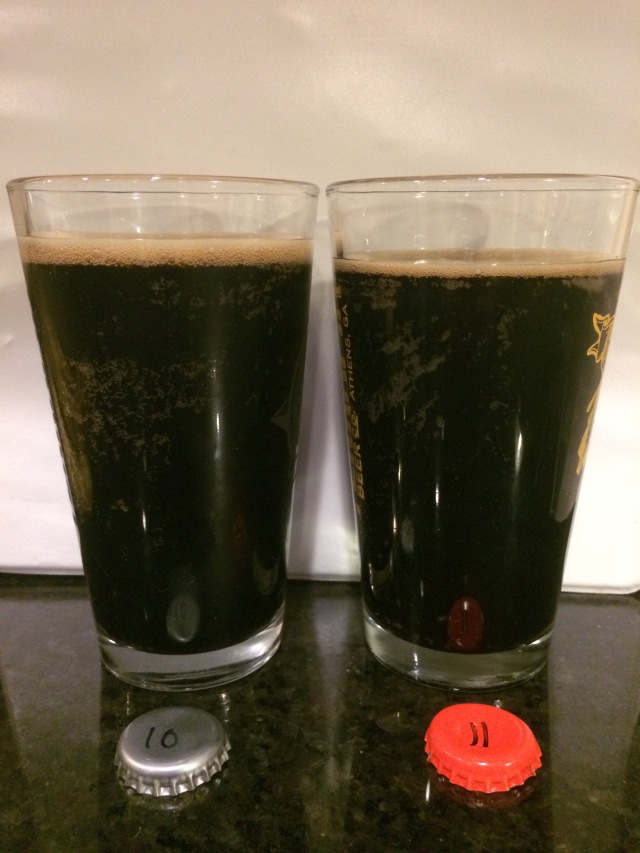This post is one in a series following six brewers collaborating to each make a small adjustment to a single recipe in order to improve it, then pass it along to the next brewer. We hope to learn more about the art of recipe creation as we see how other brewers approach the same recipe. The rest of the comparison tastings for this series can be found here.
The recipes for the beers being compared below are as follows:
| Iteration 10 | Iteration 11 | |
| Base Malt | 60.8% 2-row | 60.8% Maris Otter |
| Specialty Malt 1 | 10.6% Victory | 10.6% Victory |
| Specialty Malt 2 | 7.8% Roasted Barley | 7.8% Roasted Barley |
| Specialty Malt 3 | 1.8% Chocolate Malt | 1.8% Chocolate Malt |
| Specialty Malt 4 | 7.8% Flaked Barley | 7.8% Flaked Barley |
| Specialty Malt 5 | 5.3% Pale Chocolate | 5.3% Pale Chocolate |
| Sugar | 6% Corn Sugar | 6% Corn Sugar |
| 60 min. hop | Nugget: 42.9 IBUs | Nugget: 42.9 IBUs |
| 5 min. hop | Centennial: 6.7 IBUs | Centennial: 6.7 IBUs |
| Yeast | WYeast 1450 Denny’s Favorite 50 | WYeast 1450 Denny’s Favorite 50 |
| OG | 1.064 | 1.064 |
| FG | 1.018 | 1.021 |
| ABV | 6.1% | 5.8% |
Taster: R. Goyenko
Iteration 10 was dark, almost black, and opaque. The head was somewhat low and tan in color. The head lingered for a while before subsiding, and the bubbles were a mix of small and big ones. Iteration 11 was also dark, almost black, and opaque. The head was a tan color, about 2 inches, persistent, and left lacing on the glass walls.
Iteration 10’s aroma had notes of deep chocolate, medium-low amount of roastiness, and dark candied cherry. Iteration 11smelled of roasted grains, chocolate, dark coffee, and resiny hops. As it warmed up, a moderate amount of dark cherry was added to the aroma, and the hops become less prominent on the nose.
The flavor of Iteration 10 had a roast-forward flavor with medium bitterness from roasted grains and hops. Dark cherry esters. The bitterness was rounded by malty and chocolate flavors and didn’t feel excessive. There was a slight roasty/bitter aftertaste. The finish is medium on the palate. It also had a medium to medium-high body, with medium-low carbonation. There was no alcohol warmth, no astringency, and a creamy mouthfeel.
With Iteration 11, I noticed hop bitterness, chocolate, and espresso coffee flavors. The hops were resiny and reminiscent of grapefruit pith. This version feels hoppier than the previous one – it’s both more bitter from hops and has more flavor and aroma from them. The beer had a medium to medium-high body, with medium carbonation. There was no alcohol warmth, no astringency, and a creamy mouthfeel.
Taster: C. McKenzie
Iteration 10 poured black with a moderate tan head that showed good retention and left prominent lacing on the glass. Iteration 11 was also a deep black color, but had a slightly darker tan, almost brown head that was a bit smaller but also showed decent retention.

Iteration 10 had an aroma of choclate, espresso, cherry, and toast. Iteration 11 had a deep candy bar chocolate element to the nose, also smelling of coffee, toast, and a hint of citrus.
The flavor of Iteration 10 had notes of coffee, dark chocolate, toast, a hint of cherry, and a little bit of floral thrown in there. Iteration 11 tasted more roasty and bitter than Iteration 10. It also had flavors of coffee, dark chocolate, a touch of cherry, and a hint of citrus.
I’ll be honest—the distinction between these two beers was much less pronounced than the variations between previous versions. There was a definite difference, but I can’t guarantee the differences were based on the switch to Maris Otter rather than the inevitable differences that will occur when two brewers brew the same beer on different systems. Both were solid beers at this point in the recipe development process, and it’s getting harder to determine what I’d like to be different about this recipe.
